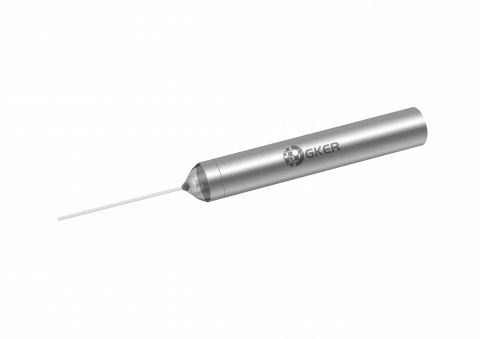Multimode Single Fiber Collimator
Description
The GKER Photonics Multimode Single Fiber Collimator (GK-MMC Series) is a versatile and high-performance optical component designed for precision in-line fiber optic applications. It serves as the foundational element for devices such as isolators and fiber wavelength division multiplexers (FWDM), ensuring efficient light transmission with minimal signal loss. This collimator features low insertion loss and high return loss, making it ideal for high-power handling scenarios.
Engineered with unique processing techniques and superior anti-reflective (AR) coating, the GK-MMC Series offers exceptional durability and performance across a range of wavelengths. It is available with various multimode fiber types and core sizes, including 105/125 µm, 62.5/125 µm, and 50/125 µm, making it adaptable to diverse optical setups. The device operates effectively over a wide temperature range, ensuring reliability in demanding environments. Whether used in telecommunications, sensors, or other advanced optical systems, the GKER Photonics Multimode Single Fiber Collimator provides the accuracy and consistency required for high-end optical applications.
Multimode Single Fiber Collimator
Specifications |
|
|---|---|
| Center Wavelength (λc): | 1310, 1550, or, specified nm |
| Operating Wavelength Range: | λc ± 30 nm |
| Working Distance: | 5, or specified mm |
| Typ. Insertion Loss: | 0.20 dB |
| Max. Insertion Loss: | 0.25 dB |
| Min. Return Loss: | 35 dB |
| Max. Tensile Load: | 5 N |
| Fiber Type: | Multimode Fiber 105/125, 62.5/125, 50/125 µm, or specified - |
| Operating Temperature: | - 5 to + 70 ℃ |
| Storage Temperature: | - 40 to + 85 ℃ |
Features
- Low Insertion Loss: Ensures efficient signal transmission with typical values as low as 0.20 dB
- High Return Loss: Provides superior signal integrity with a minimum return loss of 35 dB
- High Power Handling: Designed to manage high optical power levels, supported by advanced AR coating
- Flexible Fiber Compatibility: Supports various multimode fiber types and core sizes, including 105/125 µm, 62.5/125 µm, and 50/125 µm
- Robust Environmental Stability: Operates reliably across a wide temperature range from -5°C to +70°C, with storage capabilities down to -40°C
Applications
- Isolators: Enhances signal quality by minimizing unwanted reflections
- Fiber Wavelength Division Multiplexers (FWDM): Supports multiplexing of different wavelengths in optical networks
- High-Power Optical Systems: Ideal for systems requiring high power handling with low loss
For pricing, technical or any other questions please contact the supplier
- No registration required
- No markups, no fees
- Direct contact with supplier
-
Ships from:
China
-
Sold by:
-
On FindLight:
since 2024
Frequently Asked Questions
The collimator is available with center wavelengths of 1310 nm, 1550 nm, or a specified wavelength according to your application needs.
The typical insertion loss for the collimator is 0.20 dB, ensuring minimal signal loss during operation.
The collimator offers a minimum return loss of 35 dB, providing high signal integrity and minimizing reflections.
The collimator is compatible with multimode fibers of 105/125 µm, 62.5/125 µm, 50/125 µm, or other specified fiber types.
The collimator operates effectively within a temperature range of -5°C to +70°C, ensuring reliable performance in various environmental conditions.
Yes, the collimator is designed to handle high optical power levels, supported by its advanced AR coating and robust construction.
The typical working distance for the collimator is 5 mm, though it can be specified according to the specific requirements of your application.
Yes, this collimator is ideal for high-power optical systems due to its low insertion loss, high return loss, and advanced AR coating that supports high optical power handling.
The collimator can withstand a maximum tensile load of 5 N, ensuring durability and stability during installation and operation.
The recommended storage temperature range for the collimator is between -40°C and +85°C, ensuring that it remains in optimal condition when not in use.

